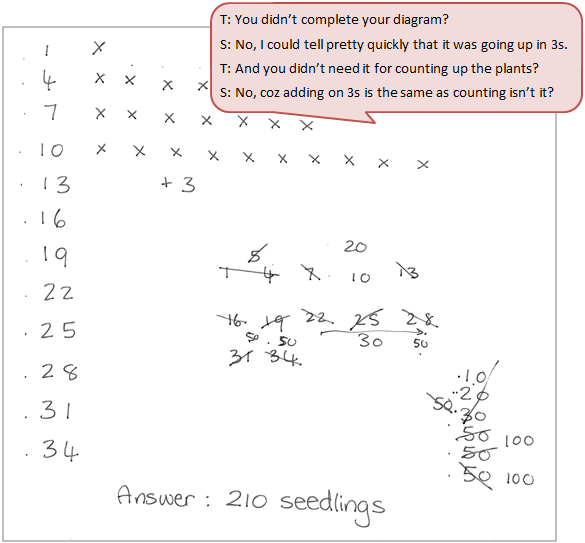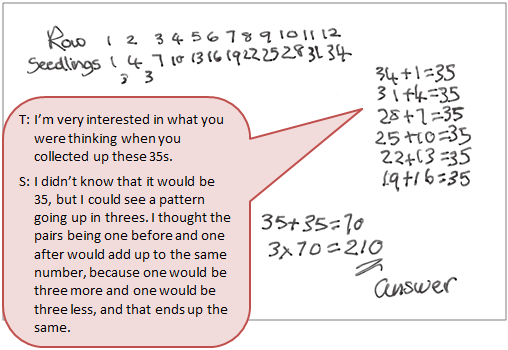Vege rows
The purpose of this activity is to engage students in using mathematical strategies to solve a sequence problem.
This activity assumes the students have experience in the following areas:
- Continuing a sequential pattern.
- Expressing the rule for a sequential or growing pattern.
- Creating arrays of items and finding the total number of items.
The problem is sufficiently open ended to allow the students freedom of choice in their approach. It may be scaffolded with guidance that leads to a solution, and/or the students might be given the opportunity to solve the problem independently.
The example responses at the end of the resource give an indication of the kind of response to expect from students who approach the problem in particular ways.

A gardener has a triangular patch of dirt that she wants to plant broccoli seedlings in.
If she spaces the seedlings correctly, she can fit twelve rows, with one seedling in the first row, four seedlings in the next, seven in the next and so on.
How many broccoli seedlings can she plant?
The following prompts illustrate how this activity can be structured around the phases of the Mathematics Investigation Cycle.
Make sense
Introduce the problem. Allow students time to read it and discuss in pairs or small groups.
- Do I understand the situation and the words? (Students may need to lay out a few rows of ‘make-believe’ seedlings to understand how the pattern grows.)
- Do I expect there to be an easy way to count the total number of seedlings? What comes to mind as an easy way?
- Have I seen a problem like this before? Where? What maths came in handy with that problem?
- What will my solution look like? (The solution will be the total number of seedlings supported by a justification that the number is correct.)
Plan approach
Discuss ideas about how to solve the problem. Emphasise that, in the planning phase, you want students to say how they would solve the problem, not to actually solve it.
- What strategies will be useful to solve a problem like this? (A diagram or physical model will be helpful but could be inefficient and not use the pattern. A table of values is likely to be very powerful in spotting patterns and relationships.)
- How will I look for a relationship between the number of seedlings in one row compared to the one before?
- Can I predict the number of seedlings in the 12th row without drawing it or continuing the table?
- What tools (digital or physical) could help my investigation?
Take action
Allow students time to work through their strategy and find a solution to the problem.
- Am I showing my workings in a step-by-step way?
- How is the pattern helping me to work more efficiently?
- How can I express the relationships I found using words and symbols? (Including tables.)
- How do my results look different or different to others? Why could this be?
- Do others have efficient ways to solve the problem? What makes those ways more efficient?
- What is my answer?
Convince yourself and others
Allow students time to check their answers and then either have them pair share with other groups or ask for volunteers to share their solution with the class.
- Can I state my solution clearly?
- Is my working clear for someone else to follow?
- Can I justify what I found using mathematical language and symbols?
- Did I try enough rows in the pattern to be confident in my rule?
- Is my rule expressed in a mathematical way?
- How would I convince someone else I am correct?
- How can I be sure that my way of adding the number of seedlings is correct?
- What tools and strategies were helpful?
Examples of work
Work sample 1
The student draws the pattern of broccoli seedlings and partitions the patch into blocks of 20 to count the total number.
Click on the image to enlarge it. Click again to close. 
Work sample 2
The student creates a table of values for the number of seedlings in each row. They notice that each row has 3 more seedlings than the previous row. They add the numbers in each row in sequence to get a total number.

